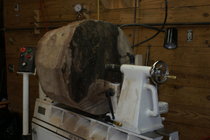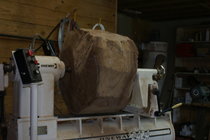- Joined
- Apr 27, 2004
- Messages
- 9,304
- Likes
- 6,058
- Location
- Lakeland, Florida
- Website
- www.hockenberywoodturning.com
o basically one “wastes” an inch or so of the blank (a little more than screw length) in order to create a tenon into which the faceplate is screwed, later turning off that tenon when the bottom of the piece is turned—and the tenon is not used to mount the piece in a four jaw chuck. Is that correct?
Yes! A couple of of points to keep in mind.
1. The screws will open a hole ahead of their depth. An inch of screw want 1 1/4 of waste tenon.
2. I want an extra wide tenon when I drive in the screws. Prevents splitting then turn it close to the faceplate diameter.
3. Faceplate is a much better hold for hollowing face grain
4. A chuck is a better hold for hollowing engrain until you get into the taller than 18” forms
Leaving the nub is handy for centering to turn off the bottom.
John Jordan used to turn his nubs short and the diameter of his faceplate hole so the faceplate would center easily.
As much as John teased me about that I never got past using pencil circles which get me close.


